

New research led by McMaster University researchers has found a program that honours dying patients by fulfilling end of life wishes can be powerful, affordable and sustainable in many settings.
Six years ago the initial Three Wishes Project began at St. Joseph’s Healthcare Hamilton, when hospital staff asked patients or their families how they might honour the life and dignity of those dying in the intensive care unit. Staff would then help families by implementing these wishes.
Now a study with three additional hospital intensive care unit sites in Toronto, Vancouver and Los Angeles, California has proven the project is a success elsewhere. The research was published in the Annals of Internal Medicine today.
The wishes range from bringing personal items and pictures from home into the ICU and providing favourite music to offering spiritual support and connecting long lost family. There are visits by favourite pets, the co-creation of keepsake crafts and celebrations including weddings. Some families have continued cherished traditions such as watching the hockey game together while enjoying a favourite beverage, or having a “date night” with take-out food from a local restaurant.
“The wishes are usually simple reflecting preferences of the dying patient. Families find the acts of compassion comforting, which strengthens their relationship with the staff. The multidisciplinary health care staff members find this type of empathic care helps to make work meaningful,” said senior author Dr. Deborah Cook.
Cook is a professor of the departments of medicine and of health research methods, evidence, and impact at McMaster University and a critical care physician at St. Joseph’s Healthcare Hamilton.
The study involved a total of 730 patients and a total of 3,407 wishes at the four hospitals of St. Joseph’s in Hamilton; St. Michael’s Hospital in Toronto, Vancouver General Hospital in Vancouver and the Ronald Reagan UCLA Medical Center in Los Angeles.
The program was started by a variety of health care providers from physicians and nurses to chaplains and social workers. Each site started the program in slightly different ways. Staff became enthusiastic, and found ways to keep the program going after the research project officially ended.
First author Meredith Vanstone, an associate professor of family medicine at McMaster, said: “Family members consistently reported the project enhanced their experience of care, easing bereavement by encouraging conversations about wishes to redirect attention from the person’s illness to his or her identity.
“We also found that as the program became more established, more frontline clinicians were comfortable initiating the Three Wishes Project independently.”
One daughter is quoted in the study saying: “It changed the focus of a negative experience into a more positive experience towards the end. We were able to focus on who my dad was, versus what’s happening to my dad.”
The cost of the program is low—about $5 per wish—said study authors, because these activities are typically done while staff is at work, and clinicians report the time requirement as typically minimal. Each site had an initial investment for reusable materials and some items were donated. Most patients had more than three wishes completed, and more than three-quarters of the wishes cost nothing.
Said one hospital administrator quoted in the study: “Honestly, if I look at the value of this project against the investment of resources, it’s hugely in favour of the value it brings. Not just from a staff perspective but from a patients and family centeredness perspective.”
The study authors summarize, by saying the project “facilitates compassionate care by recognizing the inherent dignity of dying patients and encouraging connections among patients, clinicians and family members. Local adaptions encouraged each group to take ownership of the program to suit their interest, needs and resources. When championed by bedside clinicians, the Three Wishes Project is a transferrable, affordable, and sustainable program that can provide value at the end of life.”
Source: Read Full Article